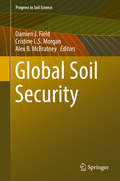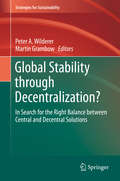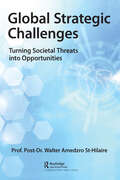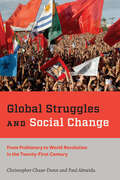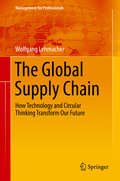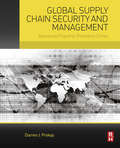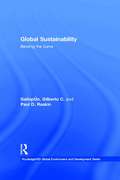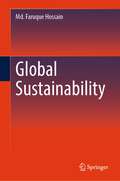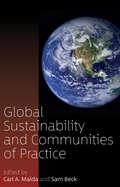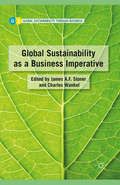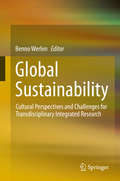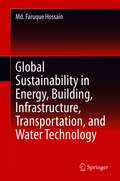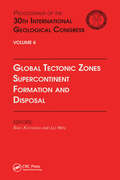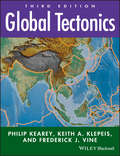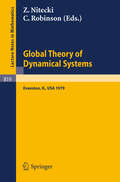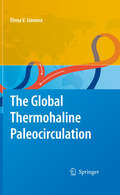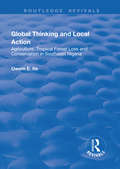- Table View
- List View
Global Soil Security: Soil Science-society Interfaces: Proceedings Of The 2nd Global Soil Security Conference, December 5-6, 2016, Paris, France (Progress in Soil Science)
by Damien J. Field, Cristine L. S. Morgan and Alex B. McBratneyThis book introduces the concept of soil security and its five dimensions: Capability, Capital, Condition, Connectivity and Codification. These five dimensions make it possible to understand soil's role in delivering ecosystem services and to quantify soil resource by measuring, mapping, modeling and managing it. Each dimension refers to a specific aspect: contribution to global challenges (Capability), value of the soil (Capital), current state of the soil (Condition), how people are connected to the soil (Connectivity) and development of good policy (Codification). This book considers soil security as an integral part of meeting the ongoing challenge to maintain human health and secure our planet's sustainability. The concept of soil security helps to achieve the need to maintain and improve the world’s soil for the purpose of producing food, fiber and freshwater, and contributing to energy and climate sustainability. At the same time it helps to maintain biodiversity and protectsecosystem goods and services.
Global Stability through Decentralization?: In Search for the Right Balance between Central and Decentral Solutions (Strategies for Sustainability)
by Peter A. Wilderer Martin GrambowThe authors of this book, who represent a broad range of scientific disciplines, discuss the issue of centralized versus decentralized control and regulation in the context of sustainable development. The stability and resilience of complex technical, economic, societal and political systems are commonly assumed to be highly dependent on the effectiveness of sophisticated, mainly centralized regulation and control systems and governance structures, respectively. In nature, however, life is mainly self-regulated by widespread, mainly DNA-encoded control mechanisms. The fact that life has endured for more than 2.4 billion years suggests that, for man-made systems, decentralized control concepts are superior to centralized ones. The authors discuss benefits and drawbacks of both approaches to achieving sustainability, providing valuable information for students and professional decision makers alike.
Global Strategic Challenges: Turning Societal Threats into Opportunities
by Walter Amedzro St-HilaireFrom his position as a Senior Fellow, the author addresses in this book the structural challenges and difficulties that predate Covid pandemic: climate change, economic inequality and the demographic challenge. These challenges raise fundamental questions of equity both between and within generations. Their immediate effects are much weaker than their long-term effects, which encourages policymakers to delay. But the cost of meeting them increases over time. These menaces raise complex technical and economic issues; some decisions must be made under great uncertainty. For each of these challenges, solutions exist: why is there little progress and how to turning threats into opportunities? In all cases, technological change is a central aspect, constituting both part of the problem and part of the solution. The solutions the author formulates are of two kinds: policy recommendations and exploratory strategic proposals. Some of the recommendations include measures that have been widely discussed but never implemented. The author wonders why these measures were never implemented? Some of the strategies are more exploratory in nature because they are new or their effects are less well understood, or because the risks associated with their implementation are significant. The author effectively analyzes the different options for exiting the crisis and explains how his proposals differ from the current reforms for global warming, inequality and population aging.
Global Strategic Challenges: Turning Societal Threats into Opportunities
by Walter Amedzro St-HilaireFrom his position as a Senior Fellow, the author addresses in this book the structural challenges and difficulties that predate Covid pandemic: climate change, economic inequality and the demographic challenge. These challenges raise fundamental questions of equity both between and within generations. Their immediate effects are much weaker than their long-term effects, which encourages policymakers to delay. But the cost of meeting them increases over time. These menaces raise complex technical and economic issues; some decisions must be made under great uncertainty. For each of these challenges, solutions exist: why is there little progress and how to turning threats into opportunities? In all cases, technological change is a central aspect, constituting both part of the problem and part of the solution. The solutions the author formulates are of two kinds: policy recommendations and exploratory strategic proposals. Some of the recommendations include measures that have been widely discussed but never implemented. The author wonders why these measures were never implemented? Some of the strategies are more exploratory in nature because they are new or their effects are less well understood, or because the risks associated with their implementation are significant. The author effectively analyzes the different options for exiting the crisis and explains how his proposals differ from the current reforms for global warming, inequality and population aging.
Global Struggles and Social Change: From Prehistory to World Revolution in the Twenty-First Century
by Christopher Chase-Dunn Paul AlmeidaIn the early decades of the twenty-first century, an international movement to slow the pace of climate change mushroomed across the globe. The self-proclaimed Climate Justice movement urges immediate action to reduce carbon emissions and calls for the adoption of bold new policies to address global warming before irreversible and catastrophic damage threatens the habitability of the planet. On another front, since the 1980s, multiple waves of resistance have occurred around the world against the uneven transition from state-led development to the neoliberal globalization project. Both Climate Justice and Anti-Austerity movements represent the urgency of understanding how global change affects the ability of citizens around the world to mobilize and protect themselves from planetary warming and the loss of social protections granted in earlier eras.In Global Struggles and Social Change, Christopher Chase-Dunn and Paul Almeida explore how global change stimulates the formation and shape of such movements. Contending that large-scale economic shifts condition the pattern of social movement mobilizations around the world, the authors trace these trends back to premodern societies, revealing how severe disruptions of indigenous communities led to innovative collective actions throughout history. Drawing on historical case studies, world system and protest event analysis, and social networks, they also examine the influence of global change processes on local, national, and transnational social movements and explain how in turn these movements shape institutional shifts. Touching on hot-button topics, including global warming, immigrant rights protests, the rise of right-wing populism, and the 2008 financial crisis, the book also explores a broad range of premodern social movements from indigenous people in the Americas, Mesopotamia, and China. The authors pay special attention to periods of disruption and external threats, as well as the role of elites, emotions, charisma, and religion or spirituality in shaping protest movements. Providing sweeping coverage, Global Struggles and Social Change is perfect for students and anyone interested in globalization, international and comparative politics, political sociology, and communication studies.
Global Struggles and Social Change: From Prehistory to World Revolution in the Twenty-First Century
by Christopher Chase-Dunn Paul AlmeidaIn the early decades of the twenty-first century, an international movement to slow the pace of climate change mushroomed across the globe. The self-proclaimed Climate Justice movement urges immediate action to reduce carbon emissions and calls for the adoption of bold new policies to address global warming before irreversible and catastrophic damage threatens the habitability of the planet. On another front, since the 1980s, multiple waves of resistance have occurred around the world against the uneven transition from state-led development to the neoliberal globalization project. Both Climate Justice and Anti-Austerity movements represent the urgency of understanding how global change affects the ability of citizens around the world to mobilize and protect themselves from planetary warming and the loss of social protections granted in earlier eras.In Global Struggles and Social Change, Christopher Chase-Dunn and Paul Almeida explore how global change stimulates the formation and shape of such movements. Contending that large-scale economic shifts condition the pattern of social movement mobilizations around the world, the authors trace these trends back to premodern societies, revealing how severe disruptions of indigenous communities led to innovative collective actions throughout history. Drawing on historical case studies, world system and protest event analysis, and social networks, they also examine the influence of global change processes on local, national, and transnational social movements and explain how in turn these movements shape institutional shifts. Touching on hot-button topics, including global warming, immigrant rights protests, the rise of right-wing populism, and the 2008 financial crisis, the book also explores a broad range of premodern social movements from indigenous people in the Americas, Mesopotamia, and China. The authors pay special attention to periods of disruption and external threats, as well as the role of elites, emotions, charisma, and religion or spirituality in shaping protest movements. Providing sweeping coverage, Global Struggles and Social Change is perfect for students and anyone interested in globalization, international and comparative politics, political sociology, and communication studies.
The Global Supply Chain: How Technology and Circular Thinking Transform Our Future (Management for Professionals)
by Wolfgang LehmacherThis book provides readers an in-depth understanding of the inner mechanisms and principles of the global supply chain. Authored by the Head of Supply Chain and Transport Industries at the World Economic Forum, it draws on a wealth of operational and managerial expertise in the global supply chain industry that drive the world’s economies. The book analyzes the importance and impact of globally networked sourcing, production and distribution, and presents detailed information on the opportunities, limitations and challenges of linear value and supply chain systems. Building on a series of recent industry cases and with a focus on the latest developments in actual business processes and models, it reveals how the transformation toward circular supply chains and regenerative resource management forms the basis for success and sustainability in business.“The book brings together technical, social, political, and geographical trends, suggesting how supply chain management can lead the quest for many of the world’s most pressing challenges.” Yossi Sheffi, Professor of Engineering, MIT, Head, MIT Center for Transportation and Logistics“This book provides an essential roadmap, guiding the reader easily through complex developments and concepts.” John Manners-Bell, CEO Transport Intelligence and Honorary Visiting Professor, Guildhall Business School, London “With strategic foresight, Lehmacher develops a vision of a circular economy within which consumer, manufacturer and logistics companies assume collective responsibility for sustainable value creation.” Alfred Talke, Group Managing Director ALFRED TALKE Logistic Services “Those who are active in logistics and supply chain management, in practice or academia, will discover a fresh view on the whole field of activity beyond the day-to-day-business.” Prof. Dr.-Ing. Thomas Wimmer, Chairman of the Executive Board, BVL International
Global Supply Chain Security and Management: Appraising Programs, Preventing Crimes
by Darren ProkopGlobal Supply Chain Security and Management: Appraising Programs, Preventing Crimes examines the relationship between securing a supply chain and promoting more efficient worldwide trade. Historically, the primary goal of supply chain security was guarding against theft and damage. Today, supply chains are also on the frontlines in the fight against terrorism. This book showcases industry leaders and their best practices, also exploring how the government is both a policing organization and a supply chain partner. In addition, it covers the critical roles that various technologies play, focusing on how Big Data is collected and turned into knowledge. By using the tools provided, readers will gain a stronger understanding of the challenges and opportunities faced by any organization that imports or exports products.Outlines the latest technologies being used to secure infrastructuresLeverages game theory to express the strategic interactions of government and businessCovers the latest U.S. regulations and provides analytical tools to help make sense of these regulationsIncorporates the latest theories and techniques of industrial organization, economics, and security
Global Sustainability: Bending the Curve (Routledge/SEI Global Environment and Development Series #Vol. 3)
by Gilberto C. Gallopín Paul D. RaskinUnprecedented levels of wealth, technology and institutional capacity can forge a just, peaceful and ecologically resilient future. However, the authors argue, social polarization, geo-political conflict and environmental degradation are threatening the long-term well-being of humanity and the planet. Global Sustainability explores the alternative futures that could emerge from the resolution of these antagonisms. Based on extensive international and interdisciplinary research, the book identifies the perils of market-driven scenarios and considers the possibility of the failure of conventional approaches. It also, however, presents a vision of the possibility of a 'Great Transition' in which revised human values and development goals bring a new stage of civilization. It will be essential reading for all scholars and professionals interested in the future of the environment, international affairs, and sustainable development.
Global Sustainability: Bending the Curve (Routledge/SEI Global Environment and Development Series)
by Gilberto C. Gallopín Paul D. RaskinUnprecedented levels of wealth, technology and institutional capacity can forge a just, peaceful and ecologically resilient future. However, the authors argue, social polarization, geo-political conflict and environmental degradation are threatening the long-term well-being of humanity and the planet. Global Sustainability explores the alternative futures that could emerge from the resolution of these antagonisms. Based on extensive international and interdisciplinary research, the book identifies the perils of market-driven scenarios and considers the possibility of the failure of conventional approaches. It also, however, presents a vision of the possibility of a 'Great Transition' in which revised human values and development goals bring a new stage of civilization. It will be essential reading for all scholars and professionals interested in the future of the environment, international affairs, and sustainable development.
Global Sustainability
by Md. Faruque HossainThis book focuses on holistic approaches to sustainability in all sectors of environment, energy, building, and infrastructure to achieve the best-balanced global environmental, energy, building, infrastructure, transportation, and water technologies (EBITWs). It presents a series of solutions based on innovative research and applications for building a sustainable Earth for future generations. Simply, the goal of this book is to define the context of instigation to think through the scientific theories and practical technical applications of sustainability for building a better planet. Naturally this book explains a series of mechanisms to develop a sustainable world by implementing mainly practicing the following areas of Sustainable Energy, Sustainable Housing and Building Technology, Sustainable Water, Infrastructure, and Transportation Technology, Sustainable Environment which are, very much interconnected to secure a global environmental equilibrium.
Global Sustainability and Communities of Practice
by Carl A. Maida Sam BeckCollaboration between experts and the public is vital for effective community engagement aimed at improving the lives of the most vulnerable in society, whether at the local or global level. Using case-based and theoretical chapters that examine rural and urban communities of practice, this volume illustrates how participatory researchers and students, as well as policy and community leaders, find ways to engage with the broader public when it comes to global sustainability research and practice.
Global Sustainability as a Business Imperative (Global Sustainability Through Business)
by James A. F. Stoner & Charles Wankel Charles WankelThis first volume in the series addresses the pressing need to align business practices with the requirements of a sustainable world. Delivering new models for conducting business, implications of undertaking new approaches, and ways businesses are transforming and being transformed by their environments.
Global Sustainability, Cultural Perspectives and Challenges for Transdisciplinary Integrated Research
by Benno WerlenThis book offers new perspectives of transdisciplinary research, in methodological as well as theoretical respects. It provides insights in the two-fold bio-physical and the socio-cultural global embeddedness of local living conditions on the basis of selected empirical studies from Latin America, Asia, Africa, Australia and Europe. The theoretical foundations of ecological research and sustainability policies were developed at the end of the nineteenth century. They are largely based on investigations of living spaces and the evolution and differentiation of varied life forms. This perspective is embedded in the practical and theoretical European problem situations of the past and lacks social and cultural differentiation. The transformation of spatial and natural relations as a result of the globalization process is so radical that new theories are needed to solve 21st century ecological problems. Moreover, in view of the lack of an ontologically sound and promising strategy for transdisciplinary problem solving, as well as an acceptable consideration of the power of cultural schemas relating to natural living’s interpretations, there is a strong need to focus on sustainable social practices, habits and routines, rather than on predominantly living spaces or eco-topes. This book elaborates on the transdisciplinary approach by reflecting on the theoretical heritage and a global perspective of sustainability, by focusing on the primary role of a social approach in sustainability research and by putting emphasis on cultural dimension of sustainability. It postulates that global sustainability is grounded in a global understanding of our everyday activities.
Global Sustainability in Energy, Building, Infrastructure, Transportation, and Water Technology
by Md. Faruque HossainThis book focuses on holistic approaches to sustainability in all sectors of building, infrastructure, and energy to achieve a best-balanced global energy, building, infrastructure, transportation, and water technology (EBITW) system using a series of innovative research and implementation solutions. The goal of this book is to define the context for proactive consideration of scientific theories and practical technical applications of sustainable development, following main seven themes: Renewable Energy Technology, Advanced Building Design Technology, Innovative Infrastructure and Transportation Engineering, Clean Water and Sanitation, Sustainable Urban and Rural Development, Clean Environment, and Sustainable Planet; which are very much interconnected to secure the global equilibrium. The book is prepared for a wide audience including researchers, field engineers, and students.
Global Tectonic Zones, Supercontinent Formation and Disposal: Proceedings of the 30th International Geological Congress, Volume 6
by Xiao Xuchang and Liu HefuThis book is a collection of papers presented in the 30th International Geological Congress, held in Beijing, on global tectonic zones supercontinent formation and disposal. The papers deal with topics on tectonic framework, and petrology and geochemistry variations of Asian regions.
Global Tectonic Zones, Supercontinent Formation and Disposal: Proceedings of the 30th International Geological Congress, Volume 6
by Xiao Xuchang Liu HefuThis book is a collection of papers presented in the 30th International Geological Congress, held in Beijing, on global tectonic zones supercontinent formation and disposal. The papers deal with topics on tectonic framework, and petrology and geochemistry variations of Asian regions.
Global Tectonics
by Philip Kearey Keith A. Klepeis Frederick J. VineThe third edition of this widely acclaimed textbook provides a comprehensive introduction to all aspects of global tectonics, and includes major revisions to reflect the most significant recent advances in the field. A fully revised third edition of this highly acclaimed text written by eminent authors including one of the pioneers of plate tectonic theory Major revisions to this new edition reflect the most significant recent advances in the field, including new and expanded chapters on Precambrian tectonics and the supercontinent cycle and the implications of plate tectonics for environmental change Combines a historical approach with process science to provide a careful balance between geological and geophysical material in both continental and oceanic regimes Dedicated website available at www.blackwellpublishing.com/kearey/
Global Tectonics
by Philip Kearey Keith A. Klepeis Frederick J. VineThe third edition of this widely acclaimed textbook provides a comprehensive introduction to all aspects of global tectonics, and includes major revisions to reflect the most significant recent advances in the field. A fully revised third edition of this highly acclaimed text written by eminent authors including one of the pioneers of plate tectonic theory Major revisions to this new edition reflect the most significant recent advances in the field, including new and expanded chapters on Precambrian tectonics and the supercontinent cycle and the implications of plate tectonics for environmental change Combines a historical approach with process science to provide a careful balance between geological and geophysical material in both continental and oceanic regimes Dedicated website available at www.blackwellpublishing.com/kearey/
Global Temperature and Carbon Emissions (large print)
by RnibThis page shows a labelled line graph. There is a locator dot shown, which will be at the top left, when the image is the correct way up. The Y-axis on the left of the page is temperature in degrees Centigrade. It is marked every 0.2 degrees and labelled at 13 and 14 degrees. The X-axis at the bottom of the page is time in years. It is marked every 20 years and labelled every 40 years. The Y-axis on the right of the page is carbon dioxide in billions of tonnes. It is marked every 50 billion tonnes and labelled every 100 billion tonnes. The temperature data line is solid (red on large print) and the carbon dioxide data line is dotted (black on large print). Both lines start in the bottom left and go up and across to the top right.
Global Temperature and Carbon Emissions (UEB contracted)
by RnibThis page shows a labelled line graph. There is a locator dot shown, which will be at the top left, when the image is the correct way up. The Y-axis on the left of the page is temperature in degrees Centigrade. It is marked every 0.2 degrees and labelled at 13 and 14 degrees. The X-axis at the bottom of the page is time in years. It is marked every 20 years and labelled every 40 years. The Y-axis on the right of the page is carbon dioxide in billions of tonnes. It is marked every 50 billion tonnes and labelled every 100 billion tonnes. The temperature data line is solid (red on large print) and the carbon dioxide data line is dotted (black on large print). Both lines start in the bottom left and go up and across to the top right.
Global Temperature and Carbon Emissions (UEB uncontracted)
by RnibThis page shows a labelled line graph. There is a locator dot shown, which will be at the top left, when the image is the correct way up. The Y-axis on the left of the page is temperature in degrees Centigrade. It is marked every 0.2 degrees and labelled at 13 and 14 degrees. The X-axis at the bottom of the page is time in years. It is marked every 20 years and labelled every 40 years. The Y-axis on the right of the page is carbon dioxide in billions of tonnes. It is marked every 50 billion tonnes and labelled every 100 billion tonnes. The temperature data line is solid (red on large print) and the carbon dioxide data line is dotted (black on large print). Both lines start in the bottom left and go up and across to the top right.
Global Theory of Dynamical Systems: Proceedings of an International Conference Held at Northwestern University, Evanston, Illinois, June 18-22, 1979 (Lecture Notes in Mathematics #819)
by Z. Nitecki C. RobinsonThe Global Thermohaline Paleocirculation
by Elena IvanovaOriginally published in Russian in 2006, this is the first English translation of this important book on paleoceanography and paleoclimatology. Its initial publication was followed by a surge of interest in this subject prompting the author to revise and translate her original work. In the book, she successfully summarizes her own research over recent years and compiles an overview of up-to-date knowledge on past ocean circulation. The key topics include: - Modern thermohaline circulation and main stages of its development during the Cenozoic - Methods and proxies of paleoceanographic reconstruction - Variability of the meridional overturning circulation and paleoceanographic events in the North Atlantic during the last climatic cycle - Influence of the global thermohaline circulation on paleoceanographic events in the Eurasian Arctic seas, the Northern Indian Ocean, and the South China Sea - The role of the thermohaline circulation in global teleconnections in the Antarctic, Eurasian Arctic, northern Pacific and low latitudes Indo-Pacific. Comprehensive investigation of hundreds of international publications and her own results, convinced the author that the global thermohaline circulation controls the remote teleconnections on millennial-scale and partly on centennial-scale, while short-term climate signals are mainly transferred by the atmosphere. This revised and extended English edition provides the latest unpublished data, new figures and modeling results. The extensive reference list contains more than 100 publications and 140 new references.
Global Thinking and Local Action: Agriculture, Tropical Forest Loss and Conservation in Southeast Nigeria (Routledge Revivals)
by Uwem E. IteThis title was first published in 2001. Based on extensive local field research undertaken in and around the Cross River National Park in Nigeria, this book provides a socio-economic study of the tensions between agriculture and nature conservation. Taking a ’bottom-up’ approach and focussing on the farm household and the dynamics of forest farming at household level, it brings together a wealth of new information on the subject of tropical forestry, the causes and dynamics of tropical rain forest loss and the problematic relations between conservation authorities in National Parks and local people. Its conclusions raise important questions about practical ways forward in the development of such areas.
